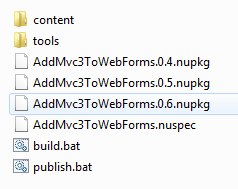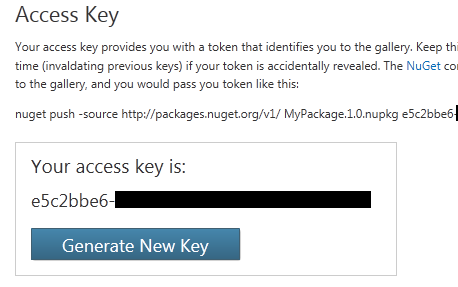Updating and Publishing a NuGet Package - Plus making NuGet packages smarter and avoiding source edits with WebActivator
I wrote a post a few days ago called "Creating a NuGet Package in 7 easy steps - Plus using NuGet to integrate ASP.NET MVC 3 into existing Web Forms applications." Long enough title? I think so.
The post exists for two reasons: First to show folks how insanely easy it is to create a NuGet package (and prompt you to make some yourself) and second to share with you some experiments where one enables new/interesting functionality after File|New Project. In that example, we had an existing ASP.NET WebForms application and added ASP.NET MVC to it in one line, making it an easy hybrid application.

Well, not really one line. In version 0.5 of the AddMvc3ToWebForms package you still have to hook up the Areas, Routes and Filters yourself in the Global.asax. I made a helper method that gets it done to one additional line, but still, it's ever so slightly lame.
Now, to THIS post that exists for two reasons: First, to show you how to create an update to a package, and what the update process looks like for the consumer. Second, to show you how (and why) you should put a tiny bit more effort in your packages up front so that things "just work" for the user.
CREATING AN UPDATE TO A NUGET PACKAGE
Step 1 - Update the NuSpec file
I opened up my AddMvc3ToWebForms.nuspec file and changed the version a notch to 0.6. I also added a dependency to another NuGet package called WebActivator that I'm going to use to make my package just work and avoid the need for that extra line of code. I'm being specific and asking for WebActivator 1.1 or higher because that version has a specific feature I need.
|
1
2
3
4
5
6
7
8
9
10
11
12
13
14
15
16
|
<?xml version="1.0"?><package xmlns:xsd="http://www.w3.org/2001/XMLSchema" xmlns:xsi="http://www.w3.org/2001/XMLSchema-instance"> <metadata xmlns="http://schemas.microsoft.com/packaging/2010/07/nuspec.xsd"> <id>AddMvc3ToWebForms</id> <version>0.6</version> <authors>Scott Hanselman</authors> <owners>Scott Hanselman</owners> <iconUrl>http://www.hanselman.com/images/nugeticon.png</iconUrl> <requireLicenseAcceptance>false</requireLicenseAcceptance> <description>A totally unsupported way to quickly add ASP.NET MVC 3 support to your WebForms Application. Works on my machine.</description> <tags>MVC MVC3 ASP.NET WebForms</tags> <dependencies> <dependency id="WebActivator" version="1.1" /> </dependencies> </metadata></package> |
Step 2 - Make your new changes
When bringing in multiple NuGet packages it's common to want to have a few things run at application startup. Perhaps setting some context, connection strings, defaults for software factories, or dependency resolvers. There are a number of packages that need this functionality, and David Ebbo created the WebActivator package to make it easier. It's a formalized wrapper around a new ASP.NET 4 attributed called "PreApplicationStartMethod," and David also enables a PostApplicationStartMethod.
In my new version of the AddMvc3ToWebForms package I created a new file called AppStart_RegisterRoutesAreasFilters.cs.pp. Note the .pp extension that signals to NuGet to preprocess the file and replace tokens like $rootnamespace$, kind of like a mini-mini-code-generator.
The rest should look familiar; we're registering the Areas, GlobalFilters and Routes. The informal naming convention is to prefix the class and file with AppStart_ so that projects that include packages that add an AppStart_*.* will group the files together.
|
1
2
3
4
5
6
7
8
9
10
11
12
13
14
15
16
17
18
19
20
21
22
23
24
25
26
27
28
29
30
31
32
33
34
35
36
37
38
39
40
|
using System;using System.Collections.Generic;using System.Linq;using System.Web;using System.Web.Mvc;using System.Web.Routing;using Microsoft.Web.Infrastructure;[assembly: WebActivator.PostApplicationStartMethod(typeof($rootnamespace$.AppStart_RegisterRoutesAreasFilters), "Start")]namespace $rootnamespace$ { public static class AppStart_RegisterRoutesAreasFilters { public static void Start() { // Set everything up with you having to do any work. // I'm doing this because it means that // your app will just run. You might want to get rid of this // and integrate with your own Global.asax. // It's up to you. AreaRegistration.RegisterAllAreas(); RegisterGlobalFilters(GlobalFilters.Filters); RegisterRoutes(RouteTable.Routes); } public static void RegisterGlobalFilters(GlobalFilterCollection filters) { filters.Add(new HandleErrorAttribute()); } public static void RegisterRoutes(RouteCollection routes) { routes.IgnoreRoute("{resource}.axd/{*pathInfo}"); routes.MapRoute( "Default", // Route name "{controller}/{action}/{id}", // URL with parameters new { controller = "Home", action = "Index", id = UrlParameter.Optional } // Parameter defaults ); } }} |
Note the line:
[assembly: WebActivator.PostApplicationStartMethod(typeof($rootnamespace$.AppStart_RegisterRoutesAreasFilters), "Start")]
David added the "PostApplicationStart" option because PreApplicationStart happens too early in the process to register Areas, so for my package, I want things to run just after App_Start. This is all new and under development, so feel free to share with David if you have any thoughts, improvements or strong opinions.
Step 3 - Build a new NuPkg file
From the command line, call...
NuGet pack
...and you'll automatically get a new file, like this screenshot:

Step 4 - Publish the Update to http://nuget.org (or any NuGet server or file share)
I could log in to my account and upload the file from the browser interface, but since I'm thinking I'll being making changes here and there, I figure it'd be nice to publish from the command line.
I'll grab my API key from the site...

..and use it to publish from the command line (using my magic new publish.bat) with contents like these:
nuget push AddMvc3ToWebForms.0.6.nupkg e5c2bbe6-xxxx
...and the result...
C:\AddMvc3ToWebForms>nuget push AddMvc3ToWebForms.0.6.nupkg e5c2bbe6-xxxx
Creating an entry for your package [ID:AddMvc3ToWebForms Ver:0.6]...
Your package was uploaded to the server but not published.
Publishing your package [ID:AddMvc3ToWebForms Ver:0.6] to the live feed...
Your package was published to the feed.
Now I'm set. I've got version 0.6 live now. What's the experience for the user of this library?
GETTING AN UPDATE TO A NUGET PACKAGE
There's two ways to find out what NuGet packages my project is using and update them.
Package Manager Console
From the package manager console I can type Get-Package...
PM> Get-Package Id Version Description
-- ------- -----------
AddMvc3ToWebForms 0.5 A totally unsupported way to quickly add ASP.NET MVC 3 support to your WebForms Application. Works on my machine.
Looks like I have version 0.5. I can update it via...
PM> Update-Package AddMvc3ToWebForms
'WebActivator (≥ 1.1)' not installed. Attempting to retrieve dependency from source...
Done.
Successfully installed 'WebActivator 1.1.0.0'.
Successfully installed 'AddMvc3ToWebForms 0.6'.
Successfully removed 'AddMvc3ToWebForms 0.5' from WebApplication7.
Successfully uninstalled 'AddMvc3ToWebForms 0.5'.
Successfully added 'WebActivator 1.1.0.0' to WebApplication7.
Successfully added 'AddMvc3ToWebForms 0.6' to WebApplication7.
Notice that NuGet automatically removed AddMvc3ToWebForms 0.5 and installed AddMvc3ToWebForms 0.6. It also automatically brought in the dependency on WebActivator 1.1.
Add Library Reference
Alternatively, from Visual Studio right click on the References node in the Solution Explorer and select Add Library Reference (or select the same directly from the Tools menu).
Select Updates from the left side. A list of updates will appear. Click Update.

It's all good. Now my AddMvc3ToWebForms NuGet Package can add ASP.NET MVC functionality to an ASP.NET WebForms projects with no additional lines of code. This makes for a nice out of the box experience, especially if I bring in other projects that use the same functionality.
Updating and Publishing a NuGet Package - Plus making NuGet packages smarter and avoiding source edits with WebActivator的更多相关文章
- 使用 dotnet CLI 来打包和发布 .NET Core nuget package
原文链接:使用 dotnet CLI 来打包和发布 .NET Core nuget package 如何使用 visual studio 2015/2017 打包和发布 Nuget package, ...
- [转]Bootstrap 3.0.0 with ASP.NET Web Forms – Step by Step – Without NuGet Package
本文转自:http://www.mytecbits.com/microsoft/dot-net/bootstrap-3-0-0-with-asp-net-web-forms In my earlier ...
- 使用NuGet Package Project快速制作NuGet包
今天在visual studio gallery发现了一个插件NuGet Package Project,通过它可以在Visual Studio中建立Nuget Package工程,直接生成Nuget ...
- 用 NuGet Package Explorer 管理你的攻城武器
缘由:每次新建一个工程,总是要从自己的“弹药库”或者之前的工程里面手动引用一些类库和脚本插件,难免有些繁琐和遗漏.想起经常用到的NuGet,跑到NuGet主页一看,发现有 NuGet Package ...
- Visual Studio 2010 更新NuGet Package Manager出错解决办法
在Visual Studio 2010的扩展管理器中发现NuGet Package Manger有最新版本更新提示,选择更新安装提示以下错误信息: 2013/4/25 1:11:48 - Micros ...
- Error This project references NuGet package(s) that are missing on this computer. Use NuGet Package Restore to download them. For more information, see http://go.microsoft.com/fwlink/?LinkID=322105. T
错误提示: Severity Code Description Project File Line Suppression StateError This project references NuG ...
- 搭建本地Nuget服务器并使用NuGet Package Explorer工具打包nuget包
1.什么是Nuget: 百度百科描述: Nuget是 ASP .NET Gallery 的一员.NuGet 是免费.开源的包管理开发工具,专注于在 .NET 应用开发过程中,简单地合并第三方的组件库. ...
- This project references NuGet package(s) that are missing on this computer.
Install Nuget. Right click on the solution and select "Enable NuGet Package Restore". Clic ...
- vs2017中生成.Net Standard Libarary的Nuget Package
场景: Project A 对Project B存在 project to project reference.这种场景下必须为两者都生成nuget package.这样在load Project A ...
随机推荐
- bootstrap AdminLTE模版的使用
参考: https://adminlte.io/themes/AdminLTE/documentation/index.html https://blog.csdn.net/gebitan505/ ...
- python--return小练习
#返回单个值,return a:#一个return后的语句不再执行,def calc_sum(*args): ax = 0 for n in args: ax = ax + nprint(ax); r ...
- 记Ubuntu Mongodb 和 Mysql的安装与使用
安装mongodb 参考链接 https://www.cnblogs.com/shileima/p/7823434.html https://blog.csdn.net/xlengji/article ...
- java获取iPhone手机图片旋转角度处理
参考原博客地址:https://www.cnblogs.com/zhao1949/p/6473882.html 这里需要的jar文件: https://files.cnblogs.com/files/ ...
- Manager解决Process进程之间的数据访问
import multiprocessing mgr = mutiprocessing.Manager() 开启一个守护子进程,并返回用来与其通信的管理器 share_list = mgr.list( ...
- Supervisor进程管理&开机自启
这几天在用supervisor管理爬虫和Flask, 每次都记不住命令,花点时间记录下. supervisor是一个进程管理工具,用来启动.停止.重启和监测进程.我用这个东西主要用来监测爬虫和Flas ...
- HDFS分布式文件系统的常用命令行操作
一.HDFS的客户端种类 1.网页形式 =>用于测试 网址为你的namenode节点的ip+50070的端口号,如: 192.168.50.128:50070 2.命令行形式 =>用于测 ...
- 如何找到fastjson.jar这个阿里开源的jar包
如何找到fastjson.jar这个阿里开源的jar包 转载 https://blog.csdn.net/AngelLover2017/article/details/84261261 Java编程中 ...
- ubantu 14.04中安装npm+node.js+react antd
今天折腾了半天,各种安装问题,最终还是装上了: 1.安装npm $ sudo apt install npm 2.升级npm $ sudo npm install npm@latest -g 输入np ...
- Xamarin Essentials教程数据传输DataTransfer
Xamarin Essentials教程数据传输DataTransfer 通过数据传输功能,应用程序可以将文本或网址发送到其它的应用程序,这样就可以在应用程序之间共享数据,实现常见的分享功能.Xa ...
